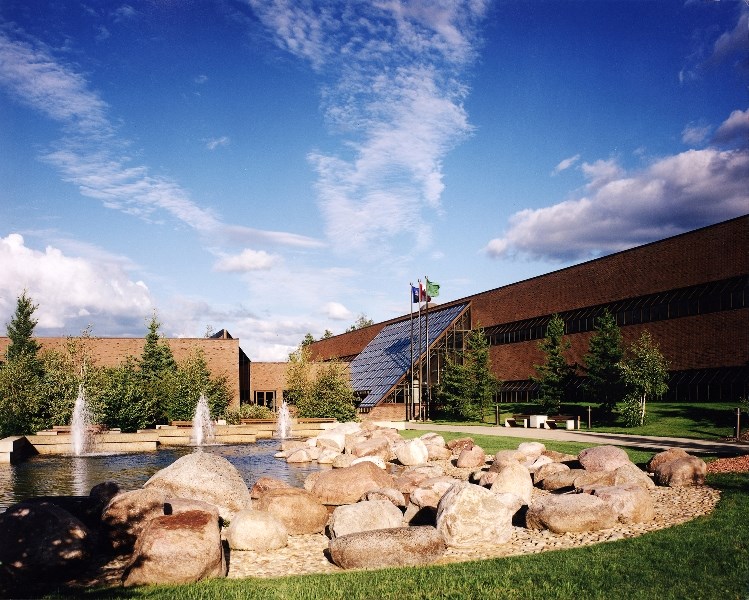“The University is not shutting down,” Athabasca University interim president Peter MacKinnon announced to members of the Athabasca District Chamber of Commerce last Wednesday.
On July 8, MacKinnon summoned a meeting with the Chamber and representatives from the Town and Athabasca County to clear up what he called, “substantial misrepresentation” of the AU Sustainability Report, through public reports and press releases from members of the AU community.
“At no point, in no place, in no part of this report was the suggestion made, or the recommendation made, that Athabasca University would move out of Athabasca,” MacKinnon stated. “It would be, to me, incredulous in this day and age, with the increasing significance of online learning, for this university not to continue and not to thrive.”
MacKinnon was addressing a press release from the Athabasca University Faculty Association (AUFA) that stated the sustainability report seemed to urge shutting down the school and moving its functions to other institutions.
The report, released in June, was spearheaded by MacKinnon and a presidential taskforce earlier this year to examine AU’s sustainability challenges and present the provincial government with four options.
“We said there are sustainability issues associated with our dispersement (of the campus), including sustainability issues arising from our presence here in Athabasca,” MacKinnon said. “That’s really a demonstrable fact in these ways: we do have difficulty recruiting people here, we have failed searches here. If you’re two professional people looking for two professional jobs in Athabasca, it can be a bit of a problem.”
He said he suspected the reason behind the alleged misrepresentation stemmed from the report identifying employment terms and conditions as a sustainability issue, such as separate bargaining agreements with onerous and costly terms.
“We were very frank about these things because we thought it’s very important to be frank,” MacKinnon said. “We thought it was part of the picture, and so we were interested in presenting an accurate and complete part of the picture.”
He explained that employment was one aspect affecting AU’s sustainability, as operating expenses continue to grow while revenues decrease. He identified a merit system for faculty and staff as one example that increased operating expenses by 2.4 per cent annually.
But AUFA and other members of the public have also raised concerns over potential layoffs as a cost-saving measure to balance AU’s budget.
During a question-and answer period at the meeting, county councillor Denis Willcott suggested that if employees were to be laid off, jobs should be kept for people living in Athabasca and who want to stay in town.
“You already have the people here who want to live here. If there’s a layoff, wouldn’t it be better to keep the people that want to be here?” he asked.
But MacKinnon said that’s not how layoffs worked.
“When you decide that you’re going to reduce the workforce, which we did (in 2013), you reduce the workforce according to where your needs are constant or declining, or where it can best be done given the nature of the institution and what we try to do, rather than necessarily where people live,” he said.
MacKinnon added that AU’s sustainability was also due to a lack of recognition and provincial funding for out-of-province students.
He said that Athabasca University receives the lowest amount of government grants to cover its operating expenses out of 21 Alberta public institutions and two private institutions.
“We don’t get funding for our out-of-province students as we would for Alberta students, or as other Alberta universities would for out-of-province students that come to them,” he explained, since students at other universities move to Alberta to study, which isn’t the case for AU’s online students.
As a result, government funding covers 30 per cent of AU’s operating expenses, compared to 50-60 per cent at institutions like the University of Alberta, University of Calgary and University of Lethbridge.
The remaining 70 per cent of AU’s budget is paid for through tuition.
Although AU receives government funding for Alberta students, only 38 per cent of undergraduates and 30 per cent of graduate students are from Alberta.
Town councillor Steve Schafer, a former faculty member at AU, proposed attracting younger students who are considering post-secondary education.
“To what extent will AU compete for new grads out of high school to become not the institution of choice, but an institution of choice?” he asked. “It strikes me that if every other institution can invoke distance and online learning, isn’t there surely an opportunity for AU to become the institution of choice for one grad in every high school in Alberta.”
MacKinnon agreed, adding that AU recently mailed out 1,000 letters to high schools throughout Alberta in the hopes of drawing students in.
“These kids are increasingly comfortable with online learning,” he noted. “It’s that generation that should be looking at AU as a choice, as a very reasonable choice.”



